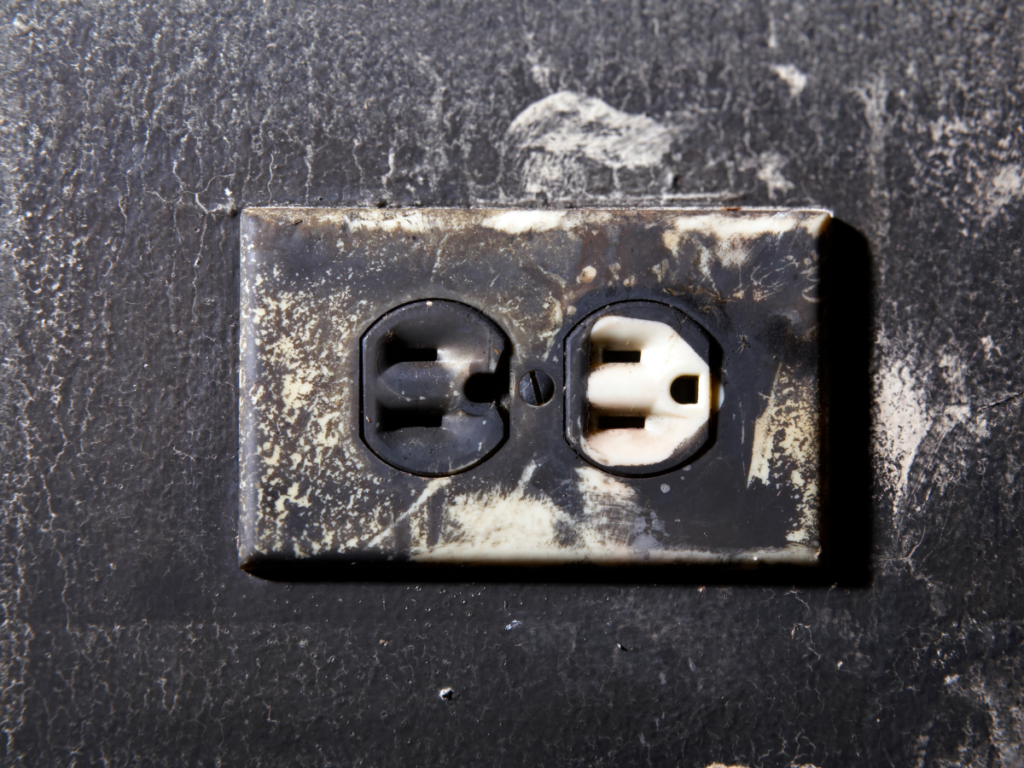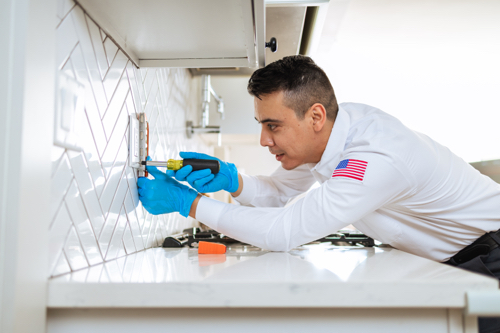 Wondering why your electrical outlet is hot to the touch? You’re not alone. Hot outlets are a common issue for homeowners.
Wondering why your electrical outlet is hot to the touch? You’re not alone. Hot outlets are a common issue for homeowners.
A hot outlet isn’t just inconvenient, it could signal serious electrical issues. Ignoring it might lead to fire hazards or permanent damage to your home’s electrical systems.
This article explains the most common reasons outlets overheat, how to troubleshoot the issue, and when to call a licensed electrician.
Key Takeaways
- A hot outlet indicates an underlying electrical problem.
- Unplug all electronic devices plugged in if the outlet feels hot to prevent further issues.
- Overloaded circuits, damaged outlets, faulty wiring, and oversized breakers are common causes.
- Call a licensed electrician if the outlet doesn’t cool down after unplugging devices.
Why Is My Outlet Hot?
When your outlet gets hot, it’s usually a sign of excess energy building up in the outlet rather than flowing smoothly to your device. This can happen for several reasons, from overloaded circuits to faulty wiring.
If your outlet is warm, it may not be an immediate concern, but if it’s hot, unplug any devices right away. Let’s break down some common causes of hot outlets and how to handle them…
Overloaded Outlets
Plugging too many devices into a single outlet or power strip can overwhelm its capacity. Most outlets are designed to handle 15 to 20 amps. When you exceed 80% of that capacity, the outlet starts generating excess heat.
What to Do: Redistribute your devices across multiple outlets and avoid overloading any one outlet. Use power strips with built-in surge protectors for safety.
Overloaded Circuit
Older homes often have circuits that can’t keep up with modern electrical demands. If a circuit is overloaded, the heat generated can travel back to the outlet. Upgrading your home’s electrical system to handle 220 volts can resolve this issue.
What to Do: Consult an electrician about upgrading your home’s electrical system to meet your energy needs.
Damaged Outlets
Worn, cracked, or broken outlets can’t handle electricity properly. Damaged outlets can lead to overheating, sparks, or even electrical fires. Regularly inspect your outlets for signs of wear.
What to Do: Replace any outlet that shows visible damage. Call an electrician to handle replacement if you’re unsure how to do it safely.
Faulty Wiring
Loose or damaged wiring behind the outlet is a common cause of overheating. Faulty wiring can lead to electrical arcing, which creates dangerous sparks and heat.
What to Do: If you suspect faulty wiring, stop using the outlet and call an electrician immediately. Faulty wiring is a fire hazard that requires professional repair.
Wall Warts (Transformers)
Devices like chargers and printers with built-in transformers convert voltage during operation, which generates heat. While a slightly warm plug is normal, a hot outlet indicates a problem.
What to Do: Unplug devices with transformers if the outlet feels hot, and let it cool before testing it again.
Incorrect Breaker or Fuse Size
Oversized breakers allow too much current to flow through circuits, while underpowered circuits can overheat when overloaded. Both scenarios create dangerous conditions.
What to Do: Verify that your breakers and fuses match your electrical system’s demands. If you’re unsure, consult an electrician.
Dimmer Switches
Dimmer switches often feel warm due to the heat they generate during power regulation. While some warmth is normal, excessive heat isn’t.
What to Do: If a dimmer switch feels unusually hot, have an electrician inspect it to rule out wiring issues or other problems.
What to Do About a Hot Outlet
 If you notice a hot outlet, take these immediate steps to ensure safety:
If you notice a hot outlet, take these immediate steps to ensure safety:
- Unplug all devices from the outlet.
- Allow the outlet to cool for at least an hour.
- Test the outlet with a simple device like a lamp.
Devices with Built-in Transformers
Transformers, like those found in chargers, generate heat during operation. If the outlet remains hot after unplugging these devices, there could be a deeper issue with the outlet or wiring.
When to Call a Professional
A hot outlet is a potential fire hazard, and it’s better to err on the side of caution.
Call a licensed electrician if:
- The outlet remains hot after unplugging devices.
- You notice visible damage to the outlet.
- Circuit breakers trip frequently.
If the outlet poses an immediate danger (e.g., sparks or smoke), call your local fire department first.
Don’t Ignore a Hot Outlet: Call Mister Sparky
 Hot outlets can be dangerous, but Service Minds Mister Sparky is here to help. We’re Tampa’s trusted electrician, providing fast and reliable service for residents and businesses. From outlet repair to complete electrical system upgrades, we’ve got you covered. Don’t wait, contact Tampa’s on-time electrician today for a safer home!
Hot outlets can be dangerous, but Service Minds Mister Sparky is here to help. We’re Tampa’s trusted electrician, providing fast and reliable service for residents and businesses. From outlet repair to complete electrical system upgrades, we’ve got you covered. Don’t wait, contact Tampa’s on-time electrician today for a safer home!
FAQs – Reasons You Have a Hot Outlet
Why is my outlet warm but not hot?
A warm outlet might be caused by a device with a transformer. This is usually normal but should still be monitored.
How can I tell if my outlet is overloaded?
If you’ve plugged multiple devices into one outlet or power strip and the outlet feels hot, it’s likely overloaded.
What should I do if my outlet sparks?
Stop using the outlet immediately and call a licensed electrician. Sparking is a sign of faulty wiring or other serious issues.
Can I replace a damaged outlet myself?
If you’re experienced with basic electrical work, you can replace it yourself. Otherwise, it’s best to hire a professional to ensure safety.
Final Thoughts
Hot outlets are more than an inconvenience, they’re a safety concern. While basic troubleshooting can help in some cases, calling a licensed electrician is the safest way to address complex issues.
Trust Service Minds Mister Sparky in Tampa, FL, for expert electrical solutions. Your home’s safety is our priority!